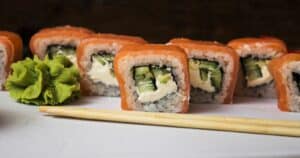Good morning, sushi lovers! Have you ever wanted to start your day with some tasty sushi rolls but weren’t sure if it was socially acceptable? We’re here to tell you that eating sushi for breakfast is absolutely A-OK! In fact, sushi makes for a very nutritious morning meal. Sushi is chock-full of healthy fats, proteins, and antioxidants from ingredients like fish, avocado, seaweed, and rice. Eating sushi in the morning provides lasting energy to fuel your busy day.
While uncommon in the West, eating sushi for breakfast is a regular habit in Japan. So if you love sushi, go for it! Just opt for rolls without raw fish and be mindful of portions. Making homemade sushi is also a great option. With the right ingredients and tools, whipping up sushi at home can be super easy. We’ll teach you how.
We will also cover why sushi makes for the perfect breakfast, debunk myths, and provide tips and tricks for making and ordering morning sushi. So grab your chopsticks and get ready to learn why sushi for breakfast rocks! Let’s dig in.
Sushi Is Packed with Essential Nutrients
One of the best things about sushi is that it provides balanced nutrition to start your day off right. Here are some of the key vitamins, minerals, and other beneficial compounds found in popular sushi ingredients:
- Fish – High-quality protein, omega-3 fatty acids, vitamin D, selenium
- Rice – Carbohydrates, B vitamins like niacin, iron, fiber
- Seaweed – Iodine, calcium, vitamin K
- Avocado – Healthy fats, potassium, fiber, vitamins C and E
- Cucumber – Vitamin K, hydration
Consuming a variety of sushi components helps you meet daily nutrient needs and gives you lasting energy. Plus, the combination of protein, carbs, and fat helps sustain you.
It’s Common Practice in Japan
Eating sushi for breakfast might seem unusual to those of us in Western cultures. But in Japan, having sushi in the morning is very common and socially acceptable. Sushi breakfasts are especially popular among busy professionals who want a quick, portable meal before commuting to work or school.
Some typical Japanese sushi breakfasts include:
- Tekka Maki – Tuna rolls
- Kappa Maki – Cucumber rolls
- Shake Maki – Salmon rolls
- Omelette Maki – Rolls with fried egg
So if you think eating sushi in the a.m. is strange, just remember it’s par for the course in Japan! The Japanese have been starting their day with sushi for centuries.
Some Precautions Are Needed
While sushi can absolutely be a smart breakfast choice, there are some precautions to keep in mind:
- Avoid raw fish – The raw fish and seafood found in some sushi is not ideal first thing in the morning when your body hasn’t built up acids to kill bacteria. Stick to cooked options like shrimp tempura or eel.
- Mind portions – Given its relatively high calories and carbs, it’s best to stick to 1-2 rolls max for breakfast. Going overboard could lead to mid-morning crashes.
- Not on an empty stomach – You’ll want to avoid eating sushi right when you wake up before anything else. Eating raw fish especially can cause upset stomach issues if you have an empty stomach. Have some miso soup, fruit, or yogurt first.
- Check ingredient safety – Some ingredients like raw fish pose risks for pregnant women, young children, the elderly, or immunocompromised individuals. Take precautions and check with your doctor.
As long as you take these considerations into account, the benefits outweigh the risks.
Making Sushi at Home Is a Cinch
If you don’t want to splurge on takeout sushi in the morning, consider making it yourself at home! With a few key tools and ingredients, you can whip up easy sushi in minutes.
You’ll Need:
- Sushi-grade fish – Opt for cooked varieties like shrimp or imitation crab.
- Sushi rice – Find at Asian grocery stores or use short-grain white rice.
- Rice vinegar – For flavoring the rice.
- Seaweed sheets – Buy roasted nori sheets.
- A bamboo rolling mat – Makes rolling easier.
- Condiments – Soy sauce, wasabi, pickled ginger.
Follow These Steps:
- Cook sushi rice per package instructions. Mix in vinegar.
- Lay out seaweed sheet and spread rice over one half.
- Layer on fillings like vegetables or cooked fish toward bottom half.
- Roll up sushi starting at the bottom using the mat.
- Slice roll into rounds and enjoy with soy, wasabi, and ginger.
Homemade sushi is endlessly customizable for your breakfast needs. Change up the fillings or experiment with sushi bowls.
Yes, You Can Make Sushi Ginger at Home Too!
Pickled ginger, or gari, is a perfect complement to balance the flavors of sushi. Luckily, you can easily pickle your own ginger at home with just a few ingredients:
- Young ginger root – The fresher, the better. Peel and slice thinly.
- Rice vinegar – Use unseasoned for pickling.
- Sugar and salt – For flavor.
Mix heated vinegar with sugar and salt to dissolve. Pour over ginger slices and refrigerate overnight. The next day, you’ll have delicious pickled ginger to enjoy with homemade sushi breakfasts.
In Conclusion
Sushi is a great choice for breakfast that provides energy, nutrients, and satisfaction. While eating raw fish in the morning is not for everyone, there are many tasty sushi options that are totally breakfast-appropriate. So go ahead and say ohayō gozaimasu (good morning) to sushi! With the right precautions and homemade options, sushi can be part of a delicious, well-balanced morning meal.





